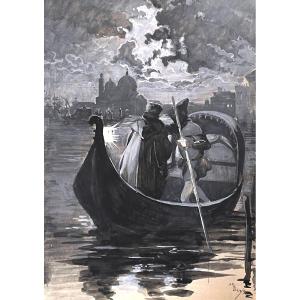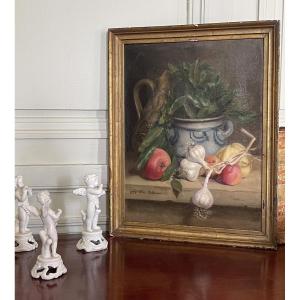An inventive painter, Joncherie repeated several times during his career this painting representing eggs in an earthenware dish cooking on their stove. In fact we know, with minor variations in composition or format, at least four other versions of our table.
Our painting is the first produced by the artist to our knowledge, because it is dated 1834.
- Christie's, New York, May 28, 1993, lot 19, signed and dated 1842, 45.8 x 38 cm.
- Christie's, London, November 16, 2006, lot 68
- Sotheby's, New York, January 25, 2008, lot 366,
- Tajan, Paris, December 18, 2019, lot 26, unsigned, undated, 47.5 x 39.5 cm.
The version mentioned in 1995 as part of a private Dutch collection in the Van Gogh Muséum magazine (R. Leeuw, "Phillippe Rousseau," in Van Gogh Museum Journal, 1995, reproduced in fig. 7.) is probably the one sold in 2006 and from the Hoogendijk collection in Amsterdam.
Sometimes the stove and the fried eggs are inserted into more abundant, less meditative compositions, like the version with the cat and peas sold on the Parisian market (Ader, Paris, December 2, 2019, lot 7.)
It is interesting to note that none of these paintings was presented at the Salon, in which Joncherie participated from 1831 to 1844.
Intimate scene, hybrid work halfway between the still life and the scene of genre, this composition was intended more for the commission of a few enlightened amateurs rather than for the bourgeois picture frames of official salons.
A LINK BETWEEN VELASQUEZ AND RIBOT
Conducive to meditation, our painting is more than a simple illustration of life daily Certainly the image is a document rich in lessons about domestic life at the time. Above all, it evokes the memory of the sweets of home. Above all, it is a silent sermon on the benefits of frugality and the serene joy of the simplest pleasures. An invitation to temperance and silence, our painting can be deciphered like an allegory. The broken egg in the foreground warns of the fragility of earthly life, and of the vanity of goods here below.
The glowing fire, striking with truth, introduces a notion of time. Time that passes and that is numbered for us, time that consumes life and reduces our bodies to ashes like the still warm embers of this stove. Joncherie claims with this painting the heir of the Spanish painters of the 17th century, artist of the “bodegones”, meditative still lifes of Zurbaran or Juan Sanchez Cotan. And in painting this work, Joncherie obviously turns to Vélasquez and his “Old woman frying eggs”, an early work kept at the National Gallery of Scotland.
By perpetuating a tradition nourished by Spanish and Flemish masters, Joncherie continues the quest for an ideal painting, seeking formal and technical perfection as well as spiritual. In doing so, he opened the way for a whole generation of artists who would succeed him and who would in turn look to the Spanish school of the 17th century to give birth to French realism. Among them are obviously François Bonvin, Antoine Vollon and Théodule Ribot.
JONCHERIE: AN ARTIST APART
A Parisian master based on rue de l'Echiquier, Gabriel Germain Joncherie remains a little-known figure, despite recent rediscoveries and publications. Born in Vitry-sur-Seine in 1785, Joncherie is distinguished by the striking singularity of his formal universe, his apparent and deceptive naivety of style, and an astonishing diversity of influences and expression. The cabinets of curiosity, between trompe l'oeil and still lifes, composed of a juxtaposition of stuffed animals, unusual objects and works of art represent an important part of his work.
Still lifes and interior views, tables of fish or game, constitute the bulk of his production. Strange portraits formed of food, in the manner of Arcimboldo, complete this anarchic panorama teeming with ideas. The variety of the works, their sometimes incongruous or confusing character, going against any contemporary artistic movement, confirms Joncherie's self-taught learning, and his emancipation from any school or academic precept and gives his works the strength of an assumed modernity. Germain Joncherie had a son, Hector François, born in 1824, who followed the same path as his father)




















 Le Magazine de PROANTIC
Le Magazine de PROANTIC TRÉSORS Magazine
TRÉSORS Magazine Rivista Artiquariato
Rivista Artiquariato
